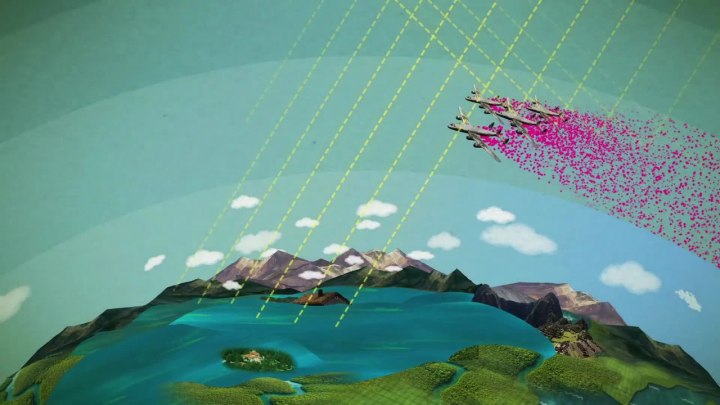
The year is 2040. Although the world has made strides toward cutting greenhouse gas emissions, the changes happened too late, and they weren’t enough. The world is gripped by droughts, extreme weather, disease, famine, rising sea levels, and more. A group of scientists from the world’s most powerful countries decides it’s time to do the unthinkable: We have to dim the sun.
That’s the kind of scenario some scientists imagine when they think about solar radiation management (SRM): A controversial geoengineering scheme that involves dispatching planes into the stratosphere at different points around the planet, and using them to release tiny reflective particles into the atmosphere. These particles would remain in the stratosphere for as long as a year and reduce global temperature by reflecting some of the sun’s heat away from Earth.
It’s not as crazy as it sounds
Daniel Cziczo, head of the department of Earth, Atmospheric and Planetary Sciences at Purdue University, tells Digital Trends that in order for such a plan to work, we’d need to release the particles near the equator.
“The stratosphere is this very stable area, so once you get material there, it sort of sloshes back and forth towards each pole. It doesn’t fall out rapidly,” Cziczo said. “What people propose doing is flying a very high altitude aircraft, and if you pump the material in near the equator, it has the tendency to move towards the wintertime pole and then, as the year goes on, back towards the other pole and so on.”

Scientists have not agreed upon a compound that would be best for such an idea. Sulfates have long been suggested, but they would do harm to the planet’s ozone layer. Aluminum oxide, calcium carbonate, and many other compounds have been suggested over the years. Scientists are currently studying different compounds in the lab and putting data into computer models to figure out if there is a compound that would reflect sunlight, wouldn’t harm the ozone layer, and wouldn’t cause problems down here on Earth once it left the stratosphere.
“The material does have to fall out, so once it falls into the troposphere, the question is what effect it will have,” Cziczo says. “On the way down, it could participate in cloud formation, it can have effects on precipitation and in extreme circumstances, it can certainly have effects on humans and ecosystems as it’s deposited. These are all things I don’t think enough research has been done on.”
It wouldn’t cost a lot of money to do it, Cziczo says. The price tag would likely be in the hundreds of millions of dollars, which isn’t a lot when you’re talking about cooling down the planet.
But it’s also pretty risky
Of course, this scheme isn’t without some serious downsides. Michael Mann, a distinguished professor of atmospheric science at Penn State University, tells Digital Trends that there could be many negative side effects to messing with the Earth’s atmosphere like this.
“Tampering with Earth’s radiation balance in an unprecedented manner is dangerous whether accidental (fossil fuel burning) or intentional (SRM),” Mann says. “The fact is that we don’t understand all of the potential side effects of sulfate aerosol geoengineering.”
Cziczo says SRM also doesn’t fix all of the problems that are caused by climate change. Temperature rise contributes to sea-level rise, extreme weather, and many other problems, but mitigating temperature rise alone wouldn’t be a silver bullet for global warming.

“It doesn’t solve the other problems of greenhouse gases, and the big one is ocean acidification. You bump up the amount of CO2 in the atmosphere, and we know we’re increasing the amount of acidity in the oceans. Some of that CO2 ends up in the oceans,” Cziczo says.
Ironically, SRM could also harm our ability to generate solar power, which is one of the energy sources we need to switch to in order to get off of fossil fuels. Because sunlight would be dimmed to some degree, solar panels would produce less power than they otherwise would.
Both Mann and Cziczo also worry that SRM could be used as an excuse to keep burning fossil fuels. If countries think we can just turn the temperature down once greenhouse gases get too high, then there’s less motivation for them to move away from fossil fuels, and there could be less motivation for companies to develop vehicles that don’t run on fossil fuels.
If this wouldn’t work, what would?
While SRM is a bit too risky to attempt, there is a geoengineering plan that Cziczo and Mann agree could help us avoid a climate catastrophe: Carbon capture and storage (CCS). This technology has been in development for years and involves machines sucking CO2 out of the air and then storing it underground or transforming it into another substance.
The Intergovernmental Panel on Climate Change (IPCC) has said we will likely need to further develop and utilize this kind of technology if we want to not only stop greenhouse gas levels from rising further but actually reduce them to what they were decades ago.
“If we’re going to solve this problem, what we have to do is find a way to start removing carbon dioxide. That’s with us long-term. Anything else is masking,” Cziczo says. “We have to figure out a way to get those greenhouse gases out of the atmosphere and find a way to sequester them.”


